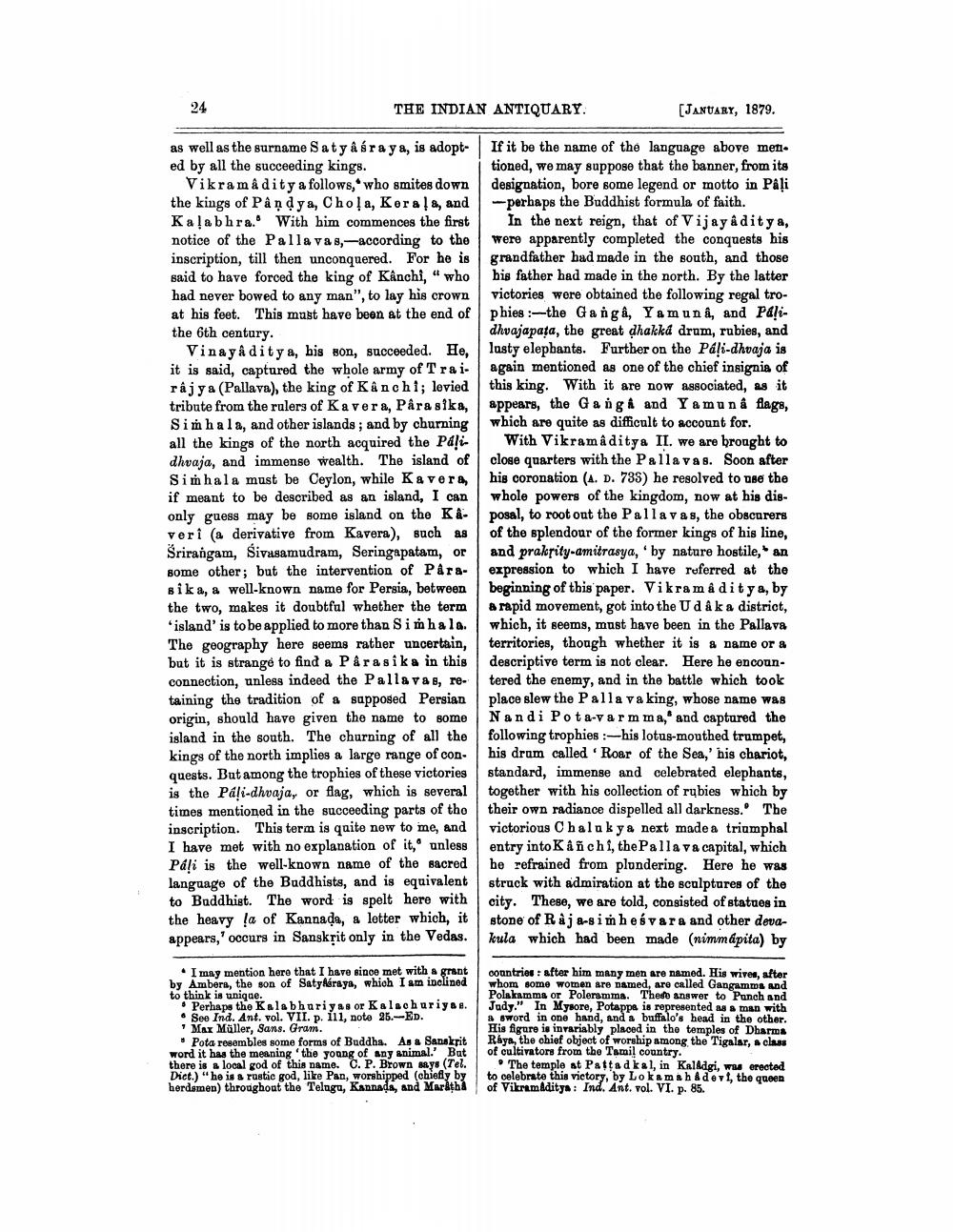________________
24
THE INDIAN ANTIQUARY.
(JANUARY, 1879.
as well as the surname Satyasraya, is adopt- If it be the name of the language above meni. ed by all the succeeding kings.
tioned, we may suppose that the banner, from its Vikramadity a follows, who smites down designation, bore some legend or motto in Pali the kings of Pandya, Chola, Kerala, and - perhaps the Buddhist formula of faith. Kalabhra. With him commences the first In the next reign, that of Vijay aditya, notice of the Palla vas,-according to the were apparently completed the conquests his inscription, till then unconquered. For he is grandfather had made in the south, and those said to have forced the king of Kanchi," who his father had made in the north. By the latter had never bowed to any man", to lay his crown victories were obtained the following regal troat his feet. This must have been at the end of phies :-the Ganga, Yamuna, and Palithe 6th century.
dhvajapata, the great dhakka drum, rubies, and Vinayaditya, his bon, succeeded. He, lasty elephants. Further on the Pali-dhvaja is it is said, captured the whole army of Trai. again mentioned as one of the chief insignia of rajya (Pallava), the king of Kanchi; levied this king. With it are now associated, as it tribute from the rulers of Kavera, Parasika, appears, the Ganga and Yamun å flags, Simhala, and other islands; and by churning which are quite as difficult to account for. all the kings of the north acquired the Papi- With Vikramaditya II. we are brought to dhvaja, and immense wealth. The island of cloge quarters with the Palla vas. Soon after Sinhala must be Ceylon, while Kavera, his coronation (A. D. 735) he resolved to use the if meant to be described as an island, I can whole powers of the kingdom, now at his disonly guess may be some island on the K&- posal, to root out the Pallav as, the obscurers veri (a derivative from Kavera), such as of the splendour of the former kings of his line, Srirangam, Sivasamudram, Seringapatam, or and praksity-amitrasya, 'by nature hostile, an some other; but the intervention of Para- expression to which I have referred at the sika, a well-known name for Persia, between beginning of this paper. Vikramaditya, by the two, makes it doubtful whether the term a rapid movement, got into the U d & ka district, ‘island' is to be applied to more than Sinhala. which, it seems, must have been in the Pallava The geography here seems rather uncertain, territories, though whether it is a name or a but it is strange to find a Parasika in this descriptive term is not clear. Here he encounconnection, unless indeed the Palla vas, re- tered the enemy, and in the battle which took taining the tradition of a supposed Persian place slew the Palla va king, whose name was origin, should have given the name to some Nandi Pota-varmma," and captured the island in the south. The churning of all the following trophies :-his lotus-mouthed trumpet, kings of the north implies a large range of con his dram called 'Roar of the Sea,' his chariot, quests. But among the trophies of these victories standard, immense and celebrated elephants, is the Pali-dhvaja, or flag, which is several together with his collection of rubies which by times mentioned in the succeeding parts of the their own radiance dispelled all darkness. The inscription. This term is quite new to me, and victorious Chalukya next made a triumphal I have met with no explanation of it, unless entry into Kanchi, the Palla va capital, which Pali is the well-known name of the sacred he refrained from plundering. Here he was language of the Buddhists, and is equivalent struck with admiration at the sculptures of the to Buddhist. The word is spelt here with city. These, we are told, consisted of statues in the heavy la of Kannada, a letter which, it stone of Raja-siṁheśvara and other devaappears,' occurs in Sanskrit only in the Vedas. kula which had been made (nimm ápita) by
• I may mention here that I have since met with a grant by Ambers, the son of Saty Aśraya, which I am inclined to think is unique.
. Perhaps the Kala bhariyas or Kalaohuriyse. • See Ind. Ant. vol. VII. p. lll, note 25.-ED.
Mar Müller, Sans. Gram. • Pota resembles some forms of Buddha. As a Sanskrit word it has the meaning the young of any animal.' Bat there is a local god of this name. C. P. Brown says (Tel. Drict.) "he is & rustic god, like Pan, worshipped (chiefly by herdemen) throughout the Telugu, Kannada, and Marktha
countries : after him many men are named. His wives, after whom some women are named, are called Gangamms and Polakamma or Poleramma. Thesto answer to Punch and Judy." In Mysore, Potappa is represented as a man with a sword in one hand, and a buffalo's head in the other. His figure is invariably placed in the temples of Dharma Ráye, the chief object of worship among the Tigalar, a class of cultivators from the Tamil country.
The temple at Pattad kal, in Kalldgi, was erected to celebrate this victory, by Lokamahadevi, the queen of Vikram Aditys: Ind. Ant. vol. VI. p. 85.




